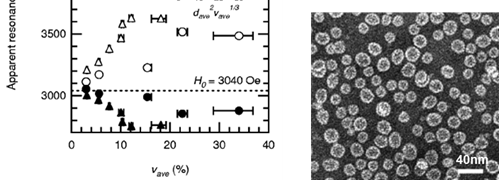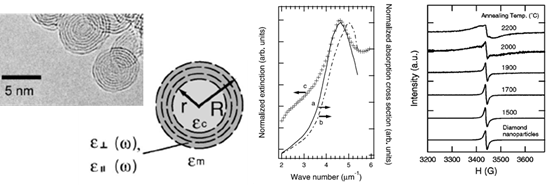Important keywords in my research are "nano materials", "electric field" and "magnetic field". In other words, I am very interested in magnetic and optical properties of nanostructured materials, for example, metallic nanoparticles. From this point of view, we are now carrying out experimental and numerical studies on metamaterials or artifitial materials, which realize extraordinary electromagnetic responses we have never observed in nature.
1. Magnetochiral Meta-Molecules and Chiral Meta-Interfaces
Keywords: magnetochiral effects, chiral meta-interface, chirality transfer,
optical activity, magneto-optical effects, circular dichloism, symmetry breaking,
magic mirror, Lorentz force on light, Berry phase, topology
It seems that sugar and magnets have little in common, however, this study reveals that
a micro-sized sugar cube with a red-colored facet "looks" to circularly polarized light like a magnet.
We prepared non-magnetic double-layer films consisting of a form of sugar, called glucose,
and a red-colored dye, called rhodamine, then we studied the absorption of circularly polarized light
in the visible region. Surprisingly, the result was very similar not to that of sugar
but to that of a magnet even though we did not apply any magnetic fields.
[33]
The key to this curious similarity is a symmetry breaking
-- the interface between transparent chiral and absorptive achiral media in the double-layer films
is essential.
Thus, we call this a "chiral meta-interface", in which "meta" means "beyond" or "higher".
The chiral meta-interface will pave the way for exploring new optical phenomena.
More recently, we found a novel route to a "one-way mirror" using an artificial molecule
-- metamolecule -- with a simultaneous break in time-reversal and space-inversion symmetries.
The metamolecule consists of a Cu helix round a magnetic ferrite rod,
which mimics chirality as being coupled to magnetism in microwave regions.
This results in directional anisotropy, called magnetochiral effects,
of microwaves under a weak static magnetic field.
The directional difference of refractive indices by the effect of the metamolecule
is several orders of magnitude larger than previous studies of natural materials.
[35]
Thanks to the simplicity of the molecular structure,
the effects can be enhanced by using resonances and making a metamaterial with the metamolecules.
Such metamaterials enable us to realize Lorentz force on light and a one-way mirror.
The achievement of this work significantly advances the physics of optics,
multiferroic phenomena, and metamaterials.
Related publications:
[35],
[33],
[32],
[P13],
[P11]

and a grant from the Research Foundation for Opto-Science and Technology.
This theme was supported by JST-CREST.
2. Periodic and Quasi-periodic Hyperbolic Metamaterials
Keywords: metal-dielectric multilayers, MIM structures, the Fibonacci sequence,
surface plasmon polaritons (SPPs), resonant tunneling of photons, superlens,
hyperlens, sub-wavelength imaging, quantum vacuum effects
Evanescent waves of light can convey information of sub-wavelength structures,
for example, nanoparticles, polymers, or proteins, but usually decay exponentially.
So, how can we transport the evanescent waves of light for long distance?
This is one of the important questions for the metamaterial superlens
that enables us to realize sub-wavelength imaging beyond the diffraction limit.
In order to answer the question, we carried out experimental and numerical studies of
resonant photon transport through multilayers consisting of silver and insulator.
We have clearly demonstrated that the complex, at times, interplay between
various electromagnetic modes including surface plasmon polaritons
in the metal-insulator-metal (MIM) system is important to obtain large tunneling probabilities
over relatively large distances approaching the wavelength.
[26]
Moreover, this study suggests that a possible application of plasmonic MIM structures
will be a novel type of hyperlens, which converts evanescent waves to propagating waves of
light.
More recently, enhancement of light-matter interaction of a quantum emitter
with subwavelength quasiperiodic metamaterials is proposed and demonstrated.
The quasiperiodic metamaterials consist of subwavelength metal-dielectric multilayers,
which are arranged into a Fibonacci lattice.
The influence of Fibonacci metamaterials (FM) on the dipole emission is analyzed
with a semiclassical model.
The local density of states near FM is evaluated and a characteristic mode in higher wave numbers
is revealed; a strong enhancement of the decay rate was predicted.
A lifetime measurement is carried out and a reduction of lifetime of quantum dots
on the surface of FM is observed.
The enhancement of light-matter interaction arises from the localized latticelike state
inherent for self-similar quasiperiodic order.
[34]
Related publications:
[34],
[26],
[21]

3. Left-Handed Meta-Materials using Spin-Waves in Ferromagnetic-Metal Nanoparticles
Keywords: ferromagnetic metal nanoparticles, left-handed materials, negative index of refraction,
magnetic resonance, spin-waves, spinelectronics
The electromagnetic responses of materials are determined by electric
permittivity and magnetic permeability.
Materials with both permittivity and permeability negative are called
left-handed materials (LHMs).
They are theoretically predicted to show extraordinary electromagnetic responses.
However, the LHMs have not been found in nature.
We are now attempting to realize the Left-Handed Meta-Materials (LHMMs)
by using ferromagnetic-metal nanocomposite films.
The results are expected to open a way to a new paradigm of electromagnetism of matter,
making a significant breakthrough in materials science and technology.
Related publication: [24],[19],[15],[13]

[Slide PDF]
and Grant-in-Aid for Scientific Research from MEXT/JSPS (KAKENHI) (23654124).
4. Novel Opto-Magnetism using Noble-Metal Nanostructures
Keywords: noble metal, nanostructures, magnetic garnet, localized surface plasmon (LSP),
optical near-field, magneto-optical effects, opto-magnetism, opto-magnetics,
spin-orbit interaction
Related publications:[17],[16]

5. Development of Novel Preparation Technique for Tailor-Made Nano-Structures
Keywords: three-dimensional metamaterials, nanocomposite, volume fraction control, biomolecules,
virus, artificial capside, gene deliverly
Films consisting of metal nanoparticles embedded in matrices are called "metal nanocomposite films"
(or "metal nanogranular films"). We are now developing novel techniques to prepare tailor-made metal
nanocomposite films. In particular, much effort has been paid to tune the particle size and particle
density (volume fraction) independently.
Related publications: [18],[15],[14],[13],[7],[6],[4],[3],[2]

6. Creation and Investigation of Carbon Onions
Keywords: carbon nanoparticles, fullerene, diamond nanoparticles,
217.5 nm interstellar extinction bump, interstellar dusts
Carbon onion, which is one of the new members of the fullerene family,
consists of concentric curved graphitic sheets.
We prepared spherical and polyhedral carbon onions in macroscopic quantities
by annealing diamond nanoparticles.
Structure and electronic properties of the carbon onions have been investigated
by high-resolution transmission electron microscopy (HRTEM), Raman spectroscopy,
electron energy-loss spectroscopy (EELS), and electron spin resonance (ESR).
The experimental results strongly suggest that the structure of spherical carbon onions
is far from perfectly closed graphitic shells and the sphericity is attributed to
imperfect sp2 graphitic shells with a number of defects such as
sp3-like dangling bonds (a defectiv spherical onion model).
pi electrons in spherical onions are thus localized in the small sp2 domains
and do not act as conduction electrons.
Furthermore, optical extinction properties of the carbon onions were studied
in the context of astronomy and astrophysics.
We have addressed the contribution of the defective onions
to the interstellar extinction bump at 217.5 nm.
Related publications:[P8],[12],[11],[8],[5],[4],[1]

